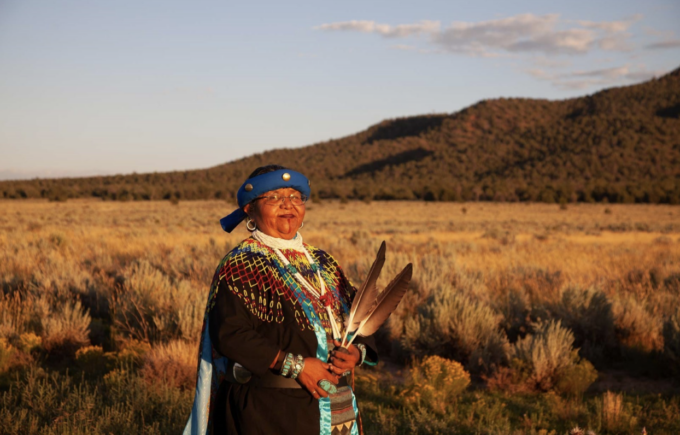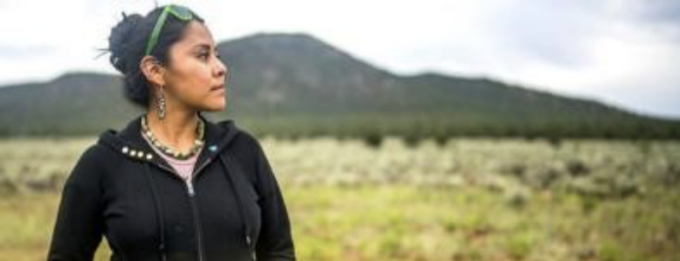
Dianna White Dove-Uqualla, Havasupai elder, activist, and ceremonialist.
“I just want to remind people that this is about nuclear war, genocide and the ongoing colonialization of our land and the ongoing takeover of our resources and we are tired of being a resource colony. We are not a sacrifice zone.”
– Leona Morgan, Diné, co-founder of Haul No!
On Saturday, Aug. 24, members of neighboring tribes and environmental groups gathered near the Grand Canyon to demonstrate against the reopening of the nearby Pinyon Plain uranium mine. An estimated 250 protestors attended. The people driving up to the Canyon from Flagstaff or Williams through piñon pines and junipers in the wide solitude of the Plateau could not miss the colorful, incongruous mass of people, placards, banners, and a few horses, 10 miles north of Grand Canyon Junction. But judging by the honks of recognition, many travelers thought it was appropriate that people should be out on a Saturday morning protesting this dangerous and grotesque aberration threatening the magnificent tranquility of the place and the health and welfare of its residents.
Probably, few of the travelers knew what Counterpunch readers have learned about disease and death caused by nuclear waste from power plants, weapons facilities, and uranium mines. Most Americans have cultivated or inherited a patriotic ignorance about all things nuclear. It’s called National Security: Shut up; Do what you’re told; Don’t think; Leave it to elite scientists and technologists.
But residents of the Colorado Plateau that stretches across northern Arizona, eastern New Mexico, and the Four Corners region, most of all the Diné (Navajo) people, have profound and intimate Insecurity about their health, amply justified by empirical proof of high rates of cancer, diabetes, kidney disease and mental retardation linked to radioactivity from mines, mine wastes, polluted aquifers and plants and animals. More than 500 of the 1,500 uranium mines on the Navajo Nation remain to be reclaimed and some residents dispute the quality of the reclamation that had been done.
Mine reclamation and remediation generally mean closing abandoned mines and removing or otherwise mitigating radioactive tailings (debris from the mine lying outside it) dangerous to human, animal and plant health.
The federal Department of Energy is responsible for mine reclamation and remediation on the Navajo Nation.
The demonstration was organized by Grand Canyon Sierra Club; Haul No!, a group formed to oppose trucking uranium ore through 300 miles of the Navajo Nation; Center for Biological Diversity; the Havasupai tribe, who live in the Grand Canyon and had experienced a flash flood two days before the demonstration; and others.
Above and behind us was Red Butte, sacred to all the tribes in the vicinity.

Leona Morgan, Diné, co-founder of Haul No! and Nuclear Issues Study Group.
Halfway through the demonstration, speakers appeared and much of the group turned away from the road to listen. The mood was ironic, dignified exasperation in the face of a simple, drastic situation, and the event became a ritual of courage: brave people standing up against another assault by a federal/multinational corporate consortium for resource colonization.
The tears of several speakers flowed with their words.
Dianna White Dove-Uqualla, a Havasupai elder, said that many tribes gathered peacefully at Red Butte to gather medicinal plants, “not just the Havasupai. But now we are on the front lines.”
Their reservation lies immediately below the Energy Fuels Inc. Pinyon Plain Mine, which has already pierced one aquifer. The Havasupai and others believe the mine will pollute the tribe’s water source, including five beautiful waterfalls, and famous tourist attractions.
“When our people get sick with cancer, mental disease, or crippled, Energy Fuels, you will pay all that you owe us. You are ripping up Mother Earth. Why are you doing this? The pollution goes to Nevada and California or Colorado. They will turn this stuff into bombs.
“But we still have a chance because we are here as one people with one heart.
“The land will die.
“The politicians are not listening. They are so mean and hurtful, not compassionate. We have lost loving kindness, but we can regain it,” White Dove-Uqualla concluded.
People felt it was a great speech and there were many “a’ho’s” of agreement from the audience.
Carletta Tilousi, a Havasupai and a member of the White House Environmental Justice Advisory Council, said that “what we’re doing so far hasn’t stopped them. Neither the state, Forest Service, nor Park Service will stop it…wherever the groundwater is leaking, it is just leading to the death of our people.
“Nothing is sacred to multi-national corporations,” she said. “The Grand Canyon is one of the seven wonders of the world. This land is sacred. Thirteen tribes hold Red Butte as a sacred site.” (The mine is close enough to the butte to pollute medicinal plants – bh)
Manuel Pino from Grants, New Mexico, said the mines in his region have not been reclaimed.
“Nowhere in the world is safe from (radioactive) waste, so how is this safe? Now there are more claims for uranium in the Black Hills than there are for gold.”
He said the federal government wants to put the waste from the Church Rock spill (the worst uranium disaster in US history) on Navajo land. Church Rock is on Navajo land. Pino suggested the government send it elsewhere.
“We never had an election to decide if we wanted uranium mining,” Pino said.
Federal law considers Indian-reservation land public land, and the 1872 Mining Act permits miners to stake claims on public lands including reservations.
“The feds have never accepted responsibility for the damage they’ve done here. Now, the new speaker of the House, Mike Johnson, blocked the extension to the Radioactive Exposure Compensation Act. Will Harris continue this policy?”
Leona Morgan, Diné, co-founder of Haul No! and the Nuclear Issues Study Group, told the group that Energy Fuel’s White Mesa Mill in Utah, close to the Ute Mountain Utes, is being used as a waste dump for uranium and other heavy metals. Recently, it received waste from Japan and has also received waste from Estonia. The Utes also say that the mine uses too much of the region’s limited supply of water. The Utes will demonstrate at the Utah State Capitol in Salt Lake and at the White Mesa Community Center in early October, Morgan added.
“I just want to remind people that this is about nuclear war, genocide and the ongoing colonialization of our land and the ongoing takeover of our resources,” she said, “and we are tired of being a resource colony. We are not a sacrifice zone.”
Haul No! will continue to oppose the mine and hauling radioactive ore across the Navajo Nation, but they are also supporting the Utes’ attempt to close White Mesa Mill, Morgan continued. Energy Fuels has two new mines in Utah, one in Colorado, and two in Wyoming. All those mines will feed the White Mesa Mill, she said.
Because the federal government recently banned the purchase of Russian uranium, domestic uranium is now the main source, Morgan explained.
“They’re coming for us, so we have to keep working together and supporting our grassroots people, our front-line people, and our colonial government, all working together for the protection of our water, our people, our cultural resources, our non-human relatives, and our future generations,” Morgan said.
The Navajo Nation and Energy Fuels Inc. have been in negotiations for a week on the transportation route for trucking uranium ore from the Pinyon Plain Mine to the White Mesa Mill. Meanwhile, a uranium mining boom is looming.
Federal, state and local politicians and the mining companies – laws and investments in their pockets — are coming back to the Navajo Nation and the surrounding land inhabited by Havasupai, Utes, Paiutes, Hualapai, Hopis, and other Pueblo tribes. The resource colonizers plan to mine more uranium, pollute more land and water, animals, crops, and medicinal plants, and sicken more people – in the name of “clean” energy and “security” for the many, but insecurity for residents of the mining area.
Support for the people who live on the uranium-rich Colorado Plateau may save your water supply, too, if you are one of the 40 million people in seven states and two Mexican states who drink Colorado River water.


